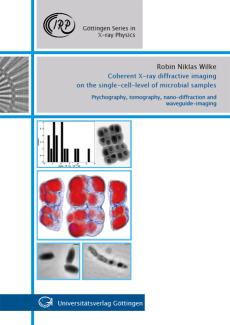Robin Niklas Wilke
Coherent X-ray diffractive imaging on the single-cell-level of microbial samples : ptychography, tomography, nano-diffraction and waveguide-imaging
Reihe: Göttingen Series in X-ray PhysicsSince its first experimental demonstration in 1999, Coherent X-Ray Diffractive Imaging has become one of the most promising high resolution X-Ray imaging techniques using coherent radiation produced by brilliant synchrotron storage rings. The ability to directly invert diffraction data with the help of advanced algorithms has paved the way for microscopic investigations and wave-field analyses on the spatial scale of nanometres without the need for inefficient imaging lenses. X-Ray phase contrast which is a measure of the electron density is an important contrast mode of soft biological specimens. For the case of many dominant elements of soft biological matter, the electron density can be converted into an effective mass density offering a unique quantitative information channel which may shed light on important questions such as DNA compaction in the bacterial nucleoid through ‚weighing with light‘. In this work X-Ray phase contrast maps have been obtained from different biological samples by exploring different methods. In particular, the techniques Ptychography and Waveguide-Holographic-Imaging have been used to obtain twodimensional and three-dimensional mass density maps on the single-cell-level of freeze-dried cells of the bacteria Deinococcus radiodurans, Bacillus subtilis and Bacillus thuringiensis allowing, for instance, to estimate the dry weight of the bacterial genome in a near native state. On top of this, reciprocal space information from coherent small angle X-Ray scattering (cellular Nano-Diffraction) of the fine structure of the bacterial cells has been recorded in a synergistic manner and has been analysed down to a resolution of about 2.3/nm exceeding current limits of direct imaging approaches. Furthermore, the dynamic range of present detector technology being one of the major limiting factors of ptychographic phasing of farfield diffraction data has been significantly increased. Overcoming this problem for the case of the very intense X-Ray beam produced by Kirkpatrick-Baez mirrors has been explored by using semi-transparent central stops.

